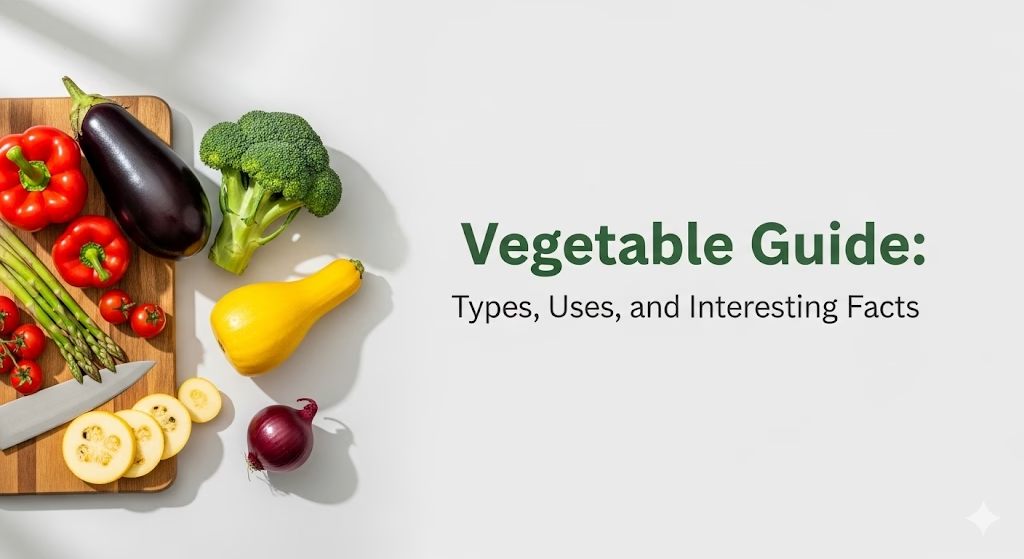What is a Vegetable?
A vegetable is an edible plant or part of a plant consumed by humans. This can include roots, stems, leaves, flowers, or seeds. Vegetables are a staple in diets worldwide, offering essential vitamins, minerals, fiber, and antioxidants.

Types of Vegetables
1. Fresh Vegetables
Fresh vegetables are harvested and consumed shortly after picking. Examples include spinach, carrots, tomatoes, and cucumbers.
2. Frozen Vegetables
Frozen vegetables are picked at peak ripeness and flash-frozen to preserve nutrients and freshness. They’re convenient, long-lasting, and ideal for busy lifestyles. Popular frozen vegetables include peas, corn, broccoli, and green beans.
3. Winter Vegetables
Winter vegetables thrive in cooler months and provide essential nutrients when fresh produce is limited. Examples:
- Kale
- Spinach
- Brussels sprouts
- Cabbage
- Carrots
4. Mixed Vegetables
Mixed vegetables are combinations of different vegetables, often used in soups, stews, and stir-fries. Packaged frozen or fresh mixes make cooking quick and easy. Common mixes include carrots, peas, green beans, corn, and bell peppers.
Common Questions About Vegetables
1. Is Corn a Vegetable?
Botanically, corn is a grain, but when harvested young and eaten fresh, it’s considered a vegetable. Corn kernels are used in salads, soups, and side dishes, and frozen corn is a pantry staple.
2. Is Avocado a Fruit or Vegetable?
Avocado is technically a fruit, specifically a large berry with a single seed. However, its culinary use is often like a vegetable due to its savory flavor in salads, guacamole, and sandwiches.
Nutritional Benefits of Vegetables
- Vitamins & Minerals: High in vitamin A, C, K, potassium, and folate.
- Fiber: Supports digestion and helps maintain healthy cholesterol levels.
- Antioxidants: Protect against free radicals and chronic diseases.
- Low Calorie: Ideal for weight management.
- Hydration: Many vegetables have high water content, keeping you hydrated.
How to Include Vegetables in Your Diet
- Raw Salads: Lettuce, carrots, bell peppers, cucumbers, and tomatoes.
- Stir-Fries: Use frozen or fresh mixed vegetables for a quick meal.
- Soups & Stews: Winter vegetables like carrots, cabbage, and kale enhance flavor.
- Smoothies: Spinach or kale blends well with fruits.
- Snacks: Carrot sticks, celery, and cherry tomatoes with dips.
Storing Vegetables
- Fresh Vegetables: Store in the refrigerator, in perforated bags to allow airflow.
- Frozen Vegetables: Keep at 0°F (-18°C) or lower; consume within 8–12 months for best quality.
- Root Vegetables: Store in a cool, dark place (like potatoes, carrots, and onions).
- Winter Vegetables: Many can be stored in a root cellar or refrigerator for weeks.
Benefits of Frozen vs Fresh Vegetables
| Feature | Fresh Vegetables | Frozen Vegetables |
|---|---|---|
| Nutrient Retention | High if eaten quickly | Very high due to flash-freezing |
| Shelf Life | Short (few days) | Long (months) |
| Convenience | Needs washing/chopping | Ready to cook |
| Cost | Seasonal, can vary | Affordable year-round |
| Variety | Seasonal | Available anytime |
Cooking Tips for Mixed Vegetables
- Avoid overcooking to preserve nutrients and texture.
- Steam or stir-fry frozen vegetables directly without thawing.
- Season lightly with olive oil, herbs, and spices for best flavor.
- Combine with grains like rice or quinoa for balanced meals.
FAQs About Vegetables
1. Are all frozen vegetables healthy?
Yes, most frozen vegetables retain most of their nutrients. Avoid added sauces or seasoning if you want a healthier option.
2. Can I grow winter vegetables at home?
Absolutely. Plant cold-hardy vegetables like spinach, kale, carrots, and cabbage in fall for winter harvest.
3. Is corn a vegetable or fruit?
Corn is a grain botanically, but in the kitchen, it is treated as a vegetable.
4. Is avocado a fruit or vegetable?
Avocado is a fruit botanically but is used like a vegetable in cooking.
5. What are the best mixed vegetables for quick meals?
Carrots, peas, corn, bell peppers, and green beans are versatile and cook quickly.
Conclusion
Vegetables, whether fresh, frozen, winter-specific, or mixed, are essential for a healthy diet. Understanding which plants are truly vegetables and how to store and cook them can improve nutrition and add variety to meals. Knowing fun facts, like corn being treated as a vegetable and avocado as a fruit, makes meal planning both educational and delicious.
Call to Action: Incorporate a variety of vegetables into your daily meals for better health and flavor. Explore more tips on seasonal vegetables and easy recipes at Agzora.com.





